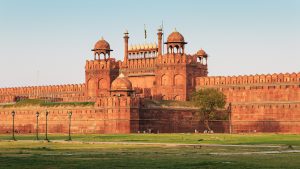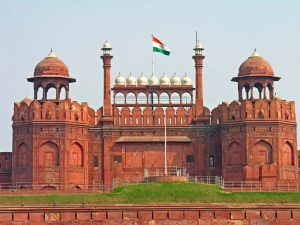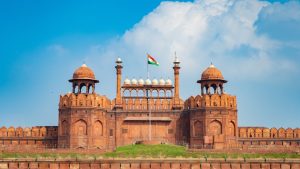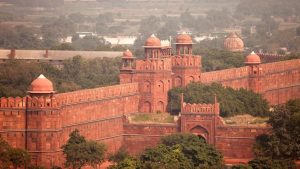DIGITAL NEWS GURU DELHI DESK:
The Red Fort: A Monument of Power, Heritage and Legacy
The Red Fort, or Lal Qila, stands as one of the most iconic symbols of India’s rich history and cultural heritage.
Located in the heart of Delhi, this magnificent fort has witnessed the rise and fall of empires, played a pivotal role in India’s freedom struggle, and continues to hold immense significance even today. Its grandeur, history, and enduring legacy make the Red Fort a symbol of India’s enduring spirit and resilience.
The Origins and Architectural Grandeur

The construction of the Red Fort began in 1638 under the orders of the Mughal Emperor Shah Jahan, who is also credited with commissioning the Taj Mahal. The fort was completed in 1648 and served as the main residence of the Mughal emperors for nearly 200 years. Shah Jahan, known for his love of art and architecture, envisioned the Red Fort as a majestic symbol of Mughal power and culture. The fort was originally named Qila-e-Mubarak, which means “The Blessed Fort.”
The fort’s design is a fine example of Mughal architecture, combining elements of Persian, Timurid, and Indian styles. Spread over an area of approximately 254 acres, the fort is shaped like an irregular octagon and is surrounded by imposing red sandstone walls that stretch over 2.5 kilometers. The walls, which rise to a height of 33 meters along the riverfront, give the fort its name, Lal Qila, or Red Fort.
Key Structures Within the Red Fort
The Red Fort complex houses several key structures that reflect the opulence and cultural sophistication of the Mughal era. Among these are:
- Diwan-i-Aam (Hall of Public Audience): This was the place where the emperor would address the general public and hear their grievances. The hall is an open pavilion with a flat roof supported by columns, and it reflects the Mughal emphasis on justice and public welfare.
- Diwan-i-Khas (Hall of Private Audience): Reserved for private meetings with the emperor’s courtiers and foreign dignitaries, this hall is richly decorated with precious stones and intricate carvings. It is here that the famous Peacock Throne once stood, a symbol of the emperor’s power and wealth.
- Rang Mahal (Palace of Colors): This was the residence of the emperor’s wives and mistresses. The interior was adorned with colorful paintings, mirrors, and fountains, creating an atmosphere of luxury and tranquility.
- Moti Masjid (Pearl Mosque): Added by Aurangzeb, Shah Jahan’s successor, the Moti Masjid is a small but elegant mosque made of white marble, symbolizing purity and spiritual devotion.
- Khas Mahal: The emperor’s private residence, this structure showcases the finest aspects of Mughal architecture, with its beautifully crafted marble and ornate ceilings.
- Lahori Gate and Delhi Gate: The two main entrances to the fort, these gates are architectural marvels in their own right. The Lahori Gate, in particular, has become a symbol of India’s sovereignty and freedom, as it is from here that the Prime Minister of India hoists the national flag on Independence Day.
Historical Significance

The Red Fort has been at the center of many significant historical events. During the Mughal era, it was the seat of the empire’s power, where policies were made, and alliances were forged. However, with the decline of the Mughal Empire, the fort saw many changes in power.
In 1739, the fort was plundered by the Persian ruler Nadir Shah, who took with him the Peacock Throne and the Kohinoor diamond, marking the beginning of the Mughal Empire’s decline. The fort also came under the control of the Marathas and later the British, who used it as a military base.
The Role in India’s Freedom Struggle

The Red Fort played a crucial role during India’s struggle for independence from British colonial rule. During the First War of Independence in 1857, the last Mughal emperor, Bahadur Shah II, was captured by the British and tried at the fort. His trial marked the end of the Mughal Empire and the beginning of direct British rule in India.
The fort later became a symbol of resistance against British rule. In 1945-46, the Red Fort Trials were held, where officers of the Indian National Army (INA), led by Subhas Chandra Bose, were tried by the British for treason. These trials ignited nationalist sentiments across the country and intensified the demand for independence.
Finally, on August 15, 1947, when India gained independence, Pandit Jawaharlal Nehru, the first Prime Minister of independent India, hoisted the national flag at the Lahori Gate of the Red Fort, a tradition that continues to this day. Every year, the Prime Minister addresses the nation from this historic site, reaffirming its significance in the collective memory of the Indian people.
The Red Fort in Modern India

Today, the Red Fort is not just a monument but a living symbol of India’s sovereignty and democratic values. It is a UNESCO World Heritage Site and one of the most visited tourist attractions in India. The fort’s preservation and restoration have been a priority for the government, and it remains a symbol of national pride.
The Red Fort has also become a venue for major cultural events, including the sound and light shows that depict the history of the fort and the Mughal Empire. These shows attract both domestic and international tourists, offering them a glimpse into India’s rich cultural heritage.
Cultural and Symbolic Legacy

The significance of the Red Fort extends beyond its historical and architectural importance. It represents the resilience and continuity of India’s cultural heritage. Despite the changes in rulers and regimes, the fort has stood the test of time, adapting to new realities while preserving its grandeur.
The Red Fort is a testament to the enduring spirit of India—a country that has emerged from centuries of colonial rule to become a vibrant democracy. It embodies the values of freedom, justice, and unity, and its walls echo the stories of the countless individuals who fought for these ideals.
A Fortress of History and Hope

The Red Fort is much more than an architectural marvel; it is a symbol of India’s historical journey and its aspirations for the future. From the grandeur of the Mughal Empire to the struggles of the independence movement, the Red Fort has been a silent witness to the events that have shaped modern India. As the nation continues to evolve, the Red Fort remains a powerful reminder of its rich past and a beacon of its enduring legacy.
YOU MAY ALSO READ: A New Chapter in Middle Eastern Conflict: The Escalating War Between Israel and Iran !








